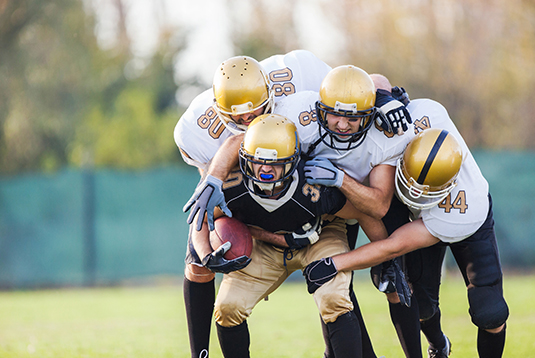
In the world of high school football, where toughness and resilience are celebrated, a dangerous myth often prevails: "No Pain, No Gain." This belief, ingrained in the minds of many young athletes, can lead to severe consequences, both physically and mentally. At our sports medicine practice, we frequently encounter athletes who have pushed themselves to the brink, all in the name of proving their toughness. Let’s explore why this mindset is harmful and how we can help change the narrative.
The Cultural Reinforcement of "No Pain, No Gain"
High school football is a sport that thrives on competition, and the pressure to perform is immense. Coaches, parents, and even teammates may unknowingly reinforce the idea that enduring pain is synonymous with strength and commitment.
- Coaches and Role Models: From a young age, athletes are often taught by coaches or parents that pain is simply part of the game. They watch professional athletes play through injuries and are encouraged to emulate this behavior, equating pain with progress and success.
- Locker Room Mentality: Within the team environment, there’s often an unspoken pressure to "tough it out." Admitting to pain or requesting a break might be perceived as weakness or as letting the team down. This culture of silence can be incredibly detrimental.
Ignoring Warning Signs
One of the most significant dangers of the "No Pain, No Gain" mentality is the tendency to ignore early warning signs of injury.
- Misinterpreting Pain: Athletes may struggle to distinguish between normal post-workout soreness and pain that signals an injury. While muscle soreness is expected after a hard practice, sharp or persistent pain, especially in joints or specific muscle groups, could indicate a serious issue, such as a ligament tear or stress fracture. However, the mindset of pushing through can lead athletes to ignore these important distinctions.
- Delayed Treatment: The reluctance to address pain early on can result in delayed medical attention. What starts as a minor injury—like a small strain or sprain—can worsen over time, leading to more severe conditions that require extended recovery periods or even surgery.
The Risk of Chronic Injuries
Playing through pain doesn’t just risk exacerbating the current injury; it can also lead to long-term complications.
- Compensatory Movements: To avoid discomfort, athletes may unknowingly change how they move, placing stress on other parts of their bodies. This compensation can result in secondary injuries, such as overuse injuries in the knees, hips, or lower back.
- Long-Term Damage: Repeatedly ignoring pain can lead to chronic injuries. For example, continuing to play despite early signs of a concussion can result in second-impact syndrome—a potentially life-threatening condition that can cause long-term neurological damage.
The Mental and Emotional Toll
The psychological impact of the "No Pain, No Gain" mentality can be just as harmful as the physical consequences.
- Psychological Pressure: Athletes may experience significant mental stress as they push through pain, fearing that acknowledging their discomfort might lead to losing their spot on the team or disappointing their coaches and peers. This pressure can take a toll on their overall well-being.
- Burnout: The relentless drive to push through pain can lead to burnout. Athletes who constantly battle injuries may lose their love for the sport, becoming exhausted and demotivated. This can lead to them quitting the sport entirely, which is a loss for both the individual and the team.
Changing the Narrative: A Call for Education and Prevention
At CLS sports medicine, Dr. Rios is committed to changing the "No Pain, No Gain" narrative.
Here’s how we can work together to protect the health and future of our athletes:
- Education: We need to educate athletes, coaches, and parents about the difference between healthy exertion and harmful pain. By teaching young athletes to listen to their bodies, recognize early warning signs of injury, and seek appropriate treatment, we can prevent minor issues from escalating.
- Supportive Environment: Creating a culture where athletes feel comfortable speaking up about pain without fear of stigma or repercussions is essential. Coaches should reinforce the idea that taking care of one’s body is crucial for long-term success, rather than glorifying the idea of pushing through pain.
- Comprehensive Care: At CLS Sports Medicine, Dr. Rios and his staff offer comprehensive evaluations and individualized treatment plans for injured athletes. We focus not only on healing current injuries but also on preventing future ones, ensuring that athletes can return to their sport stronger and healthier.
The "No Pain, No Gain" mentality is more than just a harmful belief—it’s a dangerous myth that puts the health and futures of young athletes at risk. By addressing this mindset head-on through education, support, and a focus on injury prevention, we can help athletes perform at their best while protecting their long-term well-being.
If you or someone you know is struggling with an injury, don’t hesitate to reach out to us.
We’re here to help you play smart, stay healthy, and succeed on and off the field.











